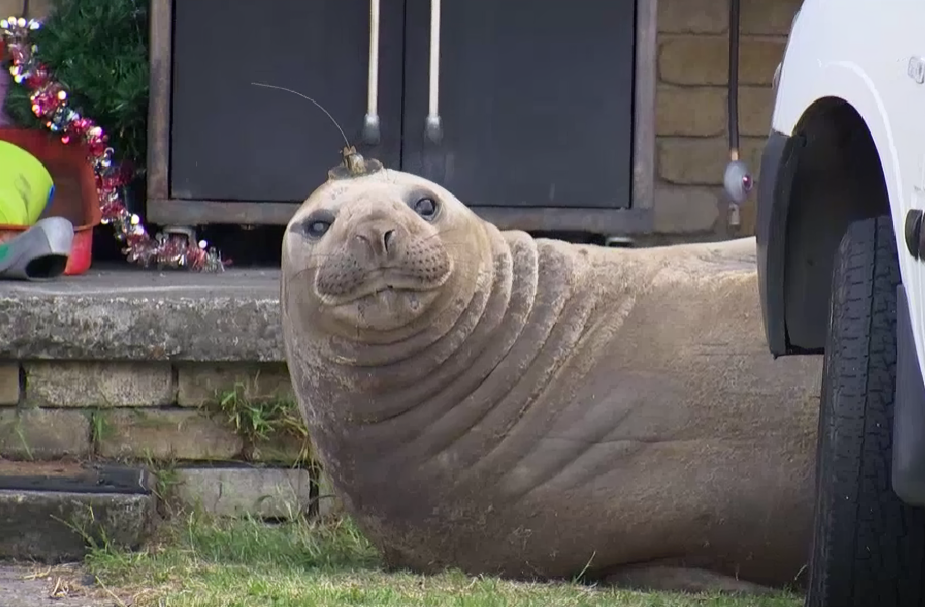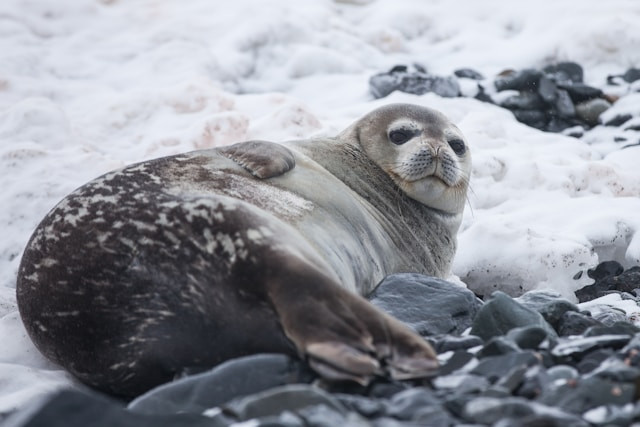600Kg Seal Blocks Tasmanian Woman From Going to Work

©️ abc.net / News
What would you do if a giant seal suddenly blocked your driveway, preventing you from getting to work?
This is exactly what happened to a Tasmanian woman when a 600kg elephant seal named Neil made an uninvited appearance in her front yard.
Imagine waking up to find a giant seal lounging in front of your car—how would you handle it? This encounter not only disrupted her morning but also turned into a charming story that captivated locals and wildlife enthusiasts alike. Curious to know how this unexpected visitor turned a typical workday into an unforgettable adventure? Read on to discover the full story behind this unique wildlife encounter.
600 Kg Seal Blocks Tasmanian Woman’s Car
Amber Harris of Primrose Sands who initially thought someone was breaking into her car around 6:20 am, was surprised to see the large seal instead.
Neil, known for his occasional visits to the area, explored Harris’s deck and garage before settling down in front of her vehicle. “I rang my boss and let her know, and she thought it was great,” Harris told ABC Radio Hobart. The unusual situation provided a light-hearted moment for her workplace, with colleagues enjoying the photos she shared.

Neil the Seal: A Local Celebrity With an Instagram Following
Neil has become a well-known figure in the community, frequently spotted at beaches and even on roads around Hobart. Tagged by Tasmania’s Marine Conservation program, Neil has gained a significant following, including his own Instagram page, where fans can track his movements and enjoy his playful antics, such as interacting with traffic cones.

Local residents, including Harris, have been proactive in ensuring Neil’s safety. They have put up banners and tape around the area and have advised people to keep a respectful distance from the animal.
Marine experts have explained that Neil might stay on land for three to four weeks, possibly for a period of hibernation, during which time he does not eat.
A Memorable Visit and a Unique Tasmanian Wildlife Experience
Harris, who lives near the beach, isn’t sure why Neil chose her yard but is happy to host the unexpected guest. “He’s welcome to stay as long as he wants,” she remarked. The incident not only provided a humorous excuse for missing work but also highlighted the unique wildlife experiences that Tasmania offers.

Neil eventually made his way back to the beach, leaving Harris and her neighbors with a memorable story. This event underscores the fascinating and sometimes surprising interactions between humans and wildlife in Tasmania, showcasing the charm and unpredictability of the region’s natural environment.
Elephant Seals: Giants of the Sea
Elephant seals are truly extraordinary creatures. Their name comes from the large, inflatable nose of adult males, which resembles an elephant’s trunk.
These marine giants are incredible divers. They can hold their breath for over two hours and plunge to depths of more than a mile! To conserve energy, they often fast for months while on land, living off their massive blubber reserves.
Despite their size, elephant seal pups are incredibly cute and helpless. Born weighing around 80 pounds, they rapidly gain weight, thanks to their mother’s incredibly rich milk.

Did you know that elephant seals were hunted almost to extinction in the 19th century? Thanks to conservation efforts, their populations have rebounded, but they still face challenges such as climate change and habitat loss.
Fun Facts About Seals
1. Amazing Divers
Some seal species, like the Weddell seal, are true champions of the deep. They can hold their breath for up to two hours, allowing them to dive to incredible depths. This is possible due to a combination of factors including increased oxygen storage in their blood and muscles, and the ability to slow their heart rate dramatically.
2. Super Sleuths
Seals have incredibly sensitive whiskers, which are packed with nerve endings. These whiskers act like sensory organs, allowing seals to detect even the slightest vibrations in the water. This helps them find prey in the dark, murky depths.
3. Warm and Cozy
Seals have evolved several adaptations to survive in frigid environments. Their thick layer of blubber acts as insulation, keeping them warm in icy waters. Additionally, their fur is water-resistant, preventing heat loss.

4. Sleepyheads
Most seals are polyphasic sleepers, meaning they sleep in short bursts throughout the day and night. They can sleep both on land and in water. Some species, like harbor seals, can even sleep while floating on the water’s surface.
5. Energetic Eaters
Seals are carnivores with high metabolisms, requiring a constant supply of food. To meet these energy demands, some species, like the crabeater seal, consume massive quantities of krill daily.
6. Super Moms
Seal milk is incredibly rich in fat and protein, providing newborn pups with the essential nutrients they need for rapid growth. This high-fat content helps pups develop a thick layer of blubber quickly to withstand the cold.

7. Clever Communicators
Seals use a variety of vocalizations to communicate with each other. These sounds can vary from loud barks and hisses to gentle clicks and purrs. They also use body language and touch to convey information.
8. Extreme Athletes
Many seal species undertake impressive migrations. For example, grey seals may travel thousands of miles between their breeding grounds and feeding areas. These migrations often involve crossing vast stretches of the ocean.
What would you do if you woke up one morning and found a seal at your door?
You may also like: Thailand to Send 2.5k Monkeys to Jail After This Recent Terror


